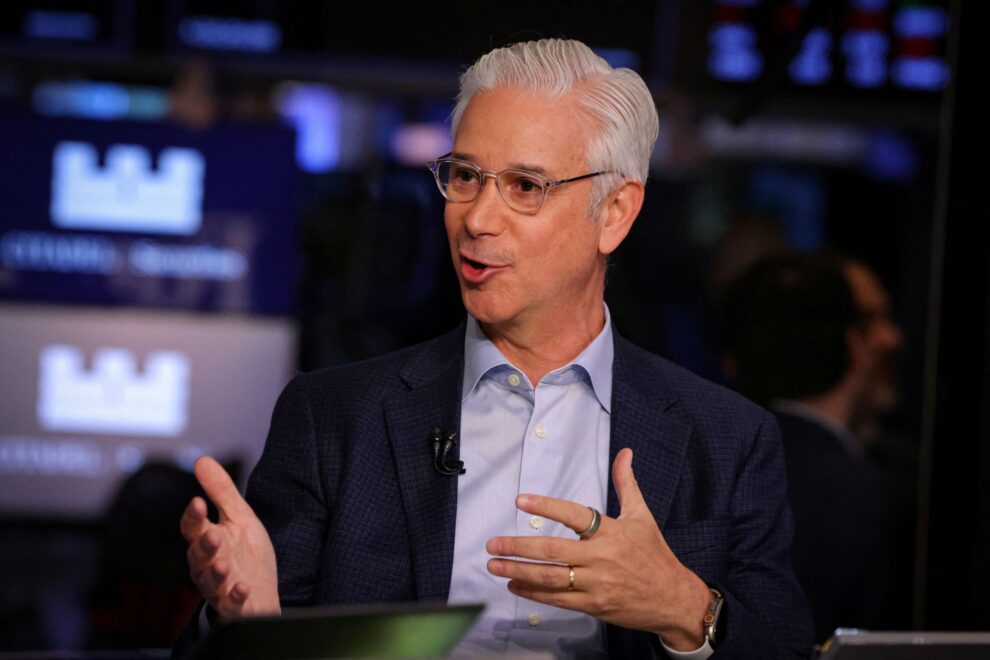
Wells Fargo reported better-than-expected second-quarter results before Tuesday’s opening bell. However, the stock was under pressure after management reduced guidance on a key banking metric. Total revenue for the three months ending June 30 increased 0.6% year over year to $20.8 billion, beating analysts’ expectations of $20.77 billion, according to market data provider LSEG. Adjusted earnings per share of $1.54 per share exceeded Wall Street’s consensus estimate of $1.41 per share, LSEG data showed. EPS excludes a 6-cent per share gain associated with the company’s acquisition of the remaining interest in its merchant services joint venture. WFC YTD mountain Wells Fargo YTD Lofty expectations may have also contributed to Tuesday’s drop in Wells Fargo shares. Before the earnings announcement, Wells Fargo shares were up nearly 19% year to date and more than 35% from their post-Liberation Day lows. The financials came into earnings season hot thanks to deregulation tailwinds and a successful round of bank stress tests, leaving Wells shares vulnerable to some profit-taking. With shares down more than 6% on the session, we view the weakness as a buying opportunity. We’re upgrading Wells Fargo stock to our 1 rating and reiterating our $90 price target. Bottom line Wells Fargo reported a solid quarter with strong fee growth and muted expense growth, leading to a 15.2% Return on Tangible Common Equity. However, two factors are creating some disappointment. First was the quarterly miss on net interest income and the cut to its full-year NII outlook. The headlines will say this is a bad thing, but Wells Fargo is deliberately prioritizing its balance sheet to focus more on its market business to support stronger client activity in products like commodities and bonds. What it will lose in NII should be made up for in non-interest income. Still, this change caught investors off guard. With the Federal Reserve asset cap finally gone, investors were hoping for better results. Keep in mind, CEO Charlie Scharf has transformed the bank over the past few years to make it less hostage to the bond market yield curve. He wants Wells Fargo to make the most money possible durably, and if that means sacrificing some NII in the short run, then so be it. “We’re not focused on maximizing net interest income. We’re focused on maximizing returns, how much money we make overall. And so we’ll try and do as good a job as we can going forward, giving some more clarity on how we intend to use that balance sheet, how it can affect the different pieces,” Scharf explained on the earnings call. We don’t think the balance sheet shift is a bad thing, since Wells Fargo is giving up some interest-rate-based revenue streams in favor of more fee growth, which we think is the better bet over the long run. A second disappointment may be related to the lack of significant balance sheet growth Wells Fargo expects for the rest of the year. But anyone expecting a growth explosion immediately after the cap was lifted hasn’t been listening to what the company has said. Scharf repeatedly said that when the asset cap is lifted, it won’t be like a “light switch” that goes off. “We never wanted to lead people to believe that there’d be any major change in the next week, the next month, the next quarter. But it certainly does open options for us to grow and increase returns beyond what we’ve seen in the past,” Scharf explained on the call. The way we see it, Scharf isn’t managing the bank on a quarter-to-quarter basis to make its NII numbers. He’s doing what’s best for the long run – strategically expanding the balance sheet and investing organically to generate the highest return for shareholders. With shares down more than 6% on the session, we think this weakness is an opportunity. We are upgrading Wells Fargo stock to our 1 rating and reiterating our $90 price target. Commentary Second quarter net interest income declined about 2% from last year to $11.7 billion, missing expectations of $11.9 billion. The bank’s net interest margin, which measures the difference in what the bank receives in interest on loans and pays out on deposits, was 2.68%, below estimates of 2.71%. The bank cited the impact of lower interest rates on floating rate assets and the impact of deposit mix changes as reasons for the decline from last year. Wells Fargo’s period-end loans were up about 1% from last year and 1% from the first quarter of 2025. On a sequential basis, commercial loans increased 2% while consumer loans were flat. Total deposits were down about 2% from both the first quarter of 2025 and the second quarter of 2024. Non-interest income increased 5% year over year to $9.11 billion, beating the Q2 consensus estimate of $8.85 billion. Even when backing out a $253 million gain on a merchant services joint venture acquisition, non-interest income still beat. Compared to last year, investment advisory fees and brokerage commissions increased 4%; investment banking fees grew 9%; card fees were up 7%; and net gains from trading activities were down 12%. Non-interest expense increased less than 1% year over year at $13.38 billion, slightly better than the consensus estimate of $13.42 billion. The increase from last year was due to increases in both personnel and non-personnel expenses. The higher personnel expense was driven by higher revenue-related compensation in wealth and investment management, while non-personnel expenses were due to increases in technology and equipment expense as well as higher advertising and promotion expenses. Still, Wells Fargo remains committed to becoming more efficient. It has reduced headcount for 20 consecutive quarters. Why we own it We bought Wells Fargo as a turnaround story under CEO Charlie Scharf. And, he has delivered. His tireless efforts to clean up the bank’s act after a series of misdeeds before his tenure paid off in the Federal Reserve finally lifting its 2018-imposed $1.95 trillion asset cap in early June. Competitors : Bank of America and Citigroup Weight in Club portfolio : 4.3% Most recent buy : Aug. 7, 2024 Initiated : Jan. 8, 2021 Wells Fargo also repurchased 43.9 million shares or $3 billion worth of stock in the quarter, bringing its share count down 5% from a year ago. That works out to an average price of $68.34, which is a great outcome with shares trading at around $79. Provisions for credit losses were about $1 billion, which was lower than the $1.18 billion expected. The bank’s allowance for credit losses for loans was up slightly from the first quarter but down from $1.23 billion in the second quarter last year. 2025 guidance Wells Fargo now expects net interest income to be roughly in line with 2024 NII of $47.7 billion. This flattish year-over-year outlook was a cut versus prior guidance of about 1% growth and about $325 million below the consensus estimate of $48.02 billion. What changed between the company’s prior guidance to now was lower NII in its markets business, which is being largely offset by higher non-interest income. Basically, as alluded to earlier, Wells Fargo is dedicating more of its balance sheet toward supporting its fee-based market business, which does not earn interest. So, the cost of funding this shift will result in lower net interest income, while most of the revenue will be recognized in non-interest income. On the expense side, Wells Fargo reaffirmed its expectation of non-interest expense of $54.2 billion. (Jim Cramer’s Charitable Trust is long WFC. See here for a full list of the stocks.) As a subscriber to the CNBC Investing Club with Jim Cramer, you will receive a trade alert before Jim makes a trade. Jim waits 45 minutes after sending a trade alert before buying or selling a stock in his charitable trust’s portfolio. If Jim has talked about a stock on CNBC TV, he waits 72 hours after issuing the trade alert before executing the trade. THE ABOVE INVESTING CLUB INFORMATION IS SUBJECT TO OUR TERMS AND CONDITIONS AND PRIVACY POLICY , TOGETHER WITH OUR DISCLAIMER . NO FIDUCIARY OBLIGATION OR DUTY EXISTS, OR IS CREATED, BY VIRTUE OF YOUR RECEIPT OF ANY INFORMATION PROVIDED IN CONNECTION WITH THE INVESTING CLUB. NO SPECIFIC OUTCOME OR PROFIT IS GUARANTEED.








